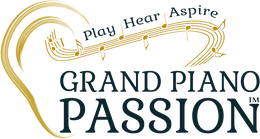“Loudness is subjective . . . so not everybody who has the same hearing loss that I do is going to want to hear music the same way,” asserts Dr. Natan Bauman, MS, Eng., Ed.D., F-AAA, a Hamden, Connecticut, audiologist with four decades of clinical experience with a background in electro-acoustics and a passion for music.
In this second article of our series on how to customize your hearing aids for playing and performing music, Grand Piano Passion™ is pleased to bring you Dr. Bauman’s unique perspective on creating the ideal music program, and why a final layer of individualized adjustments should be made.
Dr. Bauman played mandolin, guitar, and violin during high school, and although he no longer considers himself a musician, he is “one of those people who feels life is worth very little without music,” and it shows in his in-depth approach to working with musicians. Similarly to our first expert, Dr. Marshall Chasin, he maintains that the music programs offered by hearing aid manufacturers “are just totally ignorant,” so the task of customization falls to you and your audiologist.
For that customization process, Dr. Bauman agrees with most of the items on Dr. Chasin’s checklist of recommended adjustments, with a few differences, as detailed below.
Dr. Bauman’s Recommended Adjustments to Create the Best Music Program for Your Hearing Aids
Program Purely Linear Compression Ratio
Dr. Bauman strongly recommends a pure 1 to 1 compression ratio for musicians (instead of the 1.7 to 1 ratio from Dr. Chasin’s checklist). This means that the gain of the hearing aid will remain the same regardless of the input.
The human auditory system is already a non-linear amplifier, explains Dr. Bauman; by itself it changes the gain based on how much sound comes into it. Matching a non-linear amplifier with another non-linear amplifier leads to distortion of sound, so keeping the hearing aid as linear as possible helps with music perception.
Adjust Gain for Each Frequency
Dr. Bauman always gives less gain for music than for speech, since music is a continuous stream of sound information and the total amount of energy is much greater than speech. Otherwise you risk overamplifying.
In general, he reduces gain for higher frequencies (starting at 1500 Hz), but not for lower and mid frequencies. When adjusting the gain for each frequency, he considers the following questions:
- What kind of musical instrument do you play? What is the range of frequencies?
- Where is the hearing loss? How much sound are you going to hear with the hearing aid versus your naked ear if you have an open ear?
Personalize Further Based on Subjective Phenomena
Finally, one of the most important, but little talked about, factors for Dr. Bauman is the concept that loudness is subjective. Rather than being driven by objective measures such as decibels or the volume setting on a stereo, humans make decisions based on our personal perception of loudness. And that loudness can be different based on emotional components including our upbringing, culture, and all the things that make us appreciate certain sounds over others. For example, he says, “If I like country music, I will have a tendency to increase the volume and say this sounds just great. But if I hate country music, the same volume is going to make me say this is just too loud.”
Your perception of sound can also change based on factors such as your outlook on life, your mood, and even the brightness of a room at any given time. The more detail you can share with your audiologist about your unique perception of certain sounds, the closer you can get to the best music program for you.
Dr. Bauman holds seminars through the Tinnitus Practitioners Association to teach other audiologists about sound sensitivity issues and the “subjective loudness” phenomenon; he considers it his legacy to the field.
Disclosure: After I interviewed Dr. Bauman, I was so impressed with his approach to creating music settings, that I returned a few months later to buy a new pair of hearing aids. I received no payment or benefits for this article.
What kind of experiences have you had programming your hearing aid for music?





I can’t seem to get them adjusted at all for teaching. My piano students music all seems way too loud and I am unable to teach with the hearing aids if I can’t hear dynamic differences and shading. Help !
Hi Debby, that sounds very frustrating. Have you tried taking this article or the companion piece with Dr. Chaisin’s checklist to your audiologist?
I’ve been self programming since 2002. Here are a few things I have learned:
1- Turn off all sound processing before programming. Hearing aids don’t know the difference between a sustained flute and feedback so anti feedback will clamp down and there goes the treble. Likewise for any active sound processors, like noise reduction, speech enhancers, and whatever name the maker puts on it. Shut it all off. If you have feed back, then work with your audiologist to reduce it. If you still have feedback, then try the mildest setting for anti feedback and see how that affects the sound.
2 – The linear vs WRDC (wide range compression) issue is tricky. While the author is correct, you may find that linear compression sounds harsh to you, so try the WRDC. It’s a simple thing for an audiologist to change
3 – Hearing aids have 3 Gain curves to adjust sound with – soft, normal and loud. You can assume that soft means day to day conversation, normal means everyday ( and acoustic piano volume) and Loud means, well, loud. So what sounds good at conversation level won’t always sound good at loud levels. In my experience, I try for a good sound at normal levels, then tweak the soft and loud. Generally speaking, 500 hz is where “loud” is, also how loud your voice is to you, and ambient noise when you are riding in a car. So if things are too loud, try dropping 500hz first, before dropping the entire loud gain curve.
4 – Go on line and download a pitch to frequency chart. Then sit at your piano and play each note and pay attention to which notes are softer or louder than the others. Write down those notes and use teh chart to convert to frequency. This will give the audiologist a better idea of what your issues are. Generally speaking, you will find issues at B / C above middle C and F above that. Pay attention to the low end, the clarity and volume, too. Hearing aids don’t offer much adjustment at the low end, plus most audiologists will say that aids aren’t designed for low end, but you can get a pretty good low end response with a little work. Work with the “Normal” gain, and tweak soft and loud from there.
5 – This is very general – each person’s loss and how the aids work in the ear canal will be different, but I have found that Raising the low end from 750 down, to make it “flat” will give a starting point. Again, generally speaking, then bumping up the low end a couple of steps will get the low end to sound better.If you get a “booming” sound, that is occlusion, so drop back until it goes away.
6- Most aids now have a “music” channel. This can be used as a starting point, but you may find that the settings will be either too soft or too loud. That is conversation will be too soft, while music is comfortable. or conversation OK but music is too loud. That means the three gain curves – soft normal and loud, need to be spread apart more.
7- Aids have several programs – I can choose from 4. I suggest picking one for tweaking. That way, if the audiologist makes adjustments and it misses the mark, you can simply go to another program.
To Debby – It sounds like our aids have the standard “for speech” settings. And that is usually too much 500hz to 750hz. You can tell if your voice is loud to you, a coffee bean grinder is too loud, flushing a toilet is too loud, dropping an eating utensil in the sink is too loud. Play your piano and see if B above middle C is too loud, too.
Dr. Bauman “reduces gain for higher frequencies (starting at 1500 Hz), but not for lower and mid frequencies”.
Won’t that reduce the amount of high frequencies I can hear in music? I’m not a musician but an audio enthusiast and want to be able to hear a wide range of frequencies. Cymbals, for example, are more audible on my HAs “General” setting than on the “Music” setting my audiologist set up for me.
Growing up I was always able to sing in tune and was often complimented on my singing. A cookie bite hearing disability was picked up in my 30s. My first hearing aids didn’t seem to affect my singing, but it seems to be my current UK NHS hearing aids that have adversely affected my ability to hear music correctly, and I can no longer sing in tune, even using a music setting. There must be other people with this issue. Any advice??
Hi Sarah, I relate to the difficulties you are experiencing singing with your hearing loss. Have you considered bringing these suggestions for improving the music setting to your audiologist?